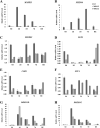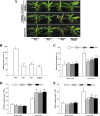MaMAPK3-MaICE1-MaPOD P7 pathway, a positive regulator of cold tolerance in banana
- PMID: 33596830
- PMCID: PMC7890976
- DOI: 10.1186/s12870-021-02868-z
MaMAPK3-MaICE1-MaPOD P7 pathway, a positive regulator of cold tolerance in banana
Abstract
Background: Banana is a tropical fruit with a high economic impact worldwide. Cold stress greatly affects the development and production of banana.
Results: In the present study, we investigated the functions of MaMAPK3 and MaICE1 involved in cold tolerance of banana. The effect of RNAi of MaMAPK3 on Dajiao (Musa spp. 'Dajiao'; ABB Group) cold tolerance was evaluated. The leaves of the MaMAPK3 RNAi transgenic plants showed wilting and severe necrotic symptoms, while the wide-type (WT) plants remained normal after cold exposure. RNAi of MaMAPK3 significantly changed the expressions of the cold-responsive genes, and the oxidoreductase activity was significantly changed in WT plants, while no changes in transgenic plants were observed. MaICE1 interacted with MaMAPK3, and the expression level of MaICE1 was significantly decreased in MaMAPK3 RNAi transgenic plants. Over-expression of MaICE1 in Cavendish banana (Musa spp. AAA group) indicated that the cold resistance of transgenic plants was superior to that of the WT plants. The POD P7 gene was significantly up-regulated in MaICE1-overexpressing transgenic plants compared with WT plants, and the POD P7 was proved to interact with MaICE1.
Conclusions: Taken together, our work provided new and solid evidence that MaMAPK3-MaICE1-MaPOD P7 pathway positively improved the cold tolerance in monocotyledon banana, shedding light on molecular breeding for the cold-tolerant banana or other agricultural species.
Keywords: Antioxidant capacity; Cold tolerance; MaICE1; MaMAPK3; MaPOD P7.
Conflict of interest statement
The authors declare that they have no competing interests.
Figures








References
-
- Lescot T. Genetic diversity of banana in figures. FruiTrop. 2008;155:29–33.
-
- Paul J, Khanna H, Kleidon J, Hoang P, Geijskes J, Daniells J, Zaplin E, Rosenberg Y, James A, Mlalazi B, et al. Golden bananas in the field: elevated fruit pro-vitamin a from the expression of a single banana transgene. Plant Biotechnol J. 2017;15(4):520–532. doi: 10.1111/pbi.12650. - DOI - PMC - PubMed
MeSH terms
Substances
Grants and funding
- 2018YFD1000302/the National Key R&D Program of China
- 31872939/National Natural Science Foundation of China
- 2018LM2150/Modern Agricultural Innovation Team Project of Guangdong Province
- 2018B020202005/R&D Plan of Guangdong Province Key Fields
- 2015B070701011/Science and Technology Plan Project of Guangdong Province
LinkOut - more resources
Full Text Sources
Other Literature Sources
Miscellaneous

